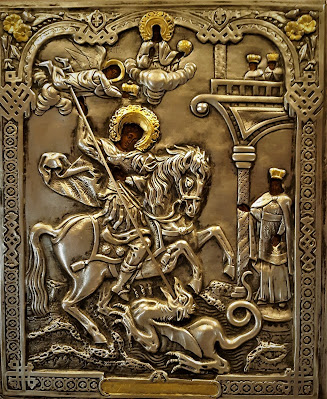During the years that followed, as Mark grew into adulthood, he witnessed the growth of the infant Church in his mother's Upper Room and came to know very well the traditions and practices of the Church, which we see included in his Gospel.
In the Acts of the Apostles we find Mark accompanying his uncle (or perhaps cousin) Barnabas and Paul on their return journey to Antioch and on their first missionary journey. But Mark wasn’t ready for the hardships of this type of work and therefore left them at Perga in Pamphylia to return home.
As the two apostles were preparing for their second missionary journey, Barnabas wanted to take Mark with him. Paul, however, objected, and so Barnabas and Mark went on a missionary journey to Cyprus. Time healed the strained relations between Paul and Mark, and during St. Paul’s first Roman captivity, Mark gave Paul valuable service, which St. Paul wrote about. When he was in chains the second time, Paul requested Mark's presence (2 Tim. 4:11).
A close friendship existed between St. Mark and St. Peter; he was Peter's companion, disciple, and interpreter. According to common patristic opinion, Mark was present at Peter's preaching in Rome and wrote his Gospel under the influence of St. Peter. This explains why incidents which involve Peter are described with great detail. Little is known of St. Mark's later life, but there is an account of his martyrdom, when he was tied to a rope and dragged over sharp stones until he was dead. At the time of his martyrdom he was the bishop of Alexandria in Egypt. His relics were transferred from Alexandria to Venice, where a worthy tomb was erected in St. Mark's Cathedral.
As the two apostles were preparing for their second missionary journey, Barnabas wanted to take Mark with him. Paul, however, objected, and so Barnabas and Mark went on a missionary journey to Cyprus. Time healed the strained relations between Paul and Mark, and during St. Paul’s first Roman captivity, Mark gave Paul valuable service, which St. Paul wrote about. When he was in chains the second time, Paul requested Mark's presence (2 Tim. 4:11).
A close friendship existed between St. Mark and St. Peter; he was Peter's companion, disciple, and interpreter. According to common patristic opinion, Mark was present at Peter's preaching in Rome and wrote his Gospel under the influence of St. Peter. This explains why incidents which involve Peter are described with great detail. Little is known of St. Mark's later life, but there is an account of his martyrdom, when he was tied to a rope and dragged over sharp stones until he was dead. At the time of his martyrdom he was the bishop of Alexandria in Egypt. His relics were transferred from Alexandria to Venice, where a worthy tomb was erected in St. Mark's Cathedral.
O Almighty God, who hast instructed thy holy Church with the heavenly doctrine of thy Evangelist Saint Mark: give us grace; that, being not like children carried away with every blast of vain doctrine, we may be established in the truth of thy holy Gospel; through Jesus Christ thy Son our Lord, who liveth and reigneth with thee, in the unity of the Holy Spirit, ever one God, world without end. Amen.
_________________________________________
Painting: "San Marco"
by Giovanni Antonio de' Sacchis "Il Pordenone" (c. 1484-1539)
.jpg)













